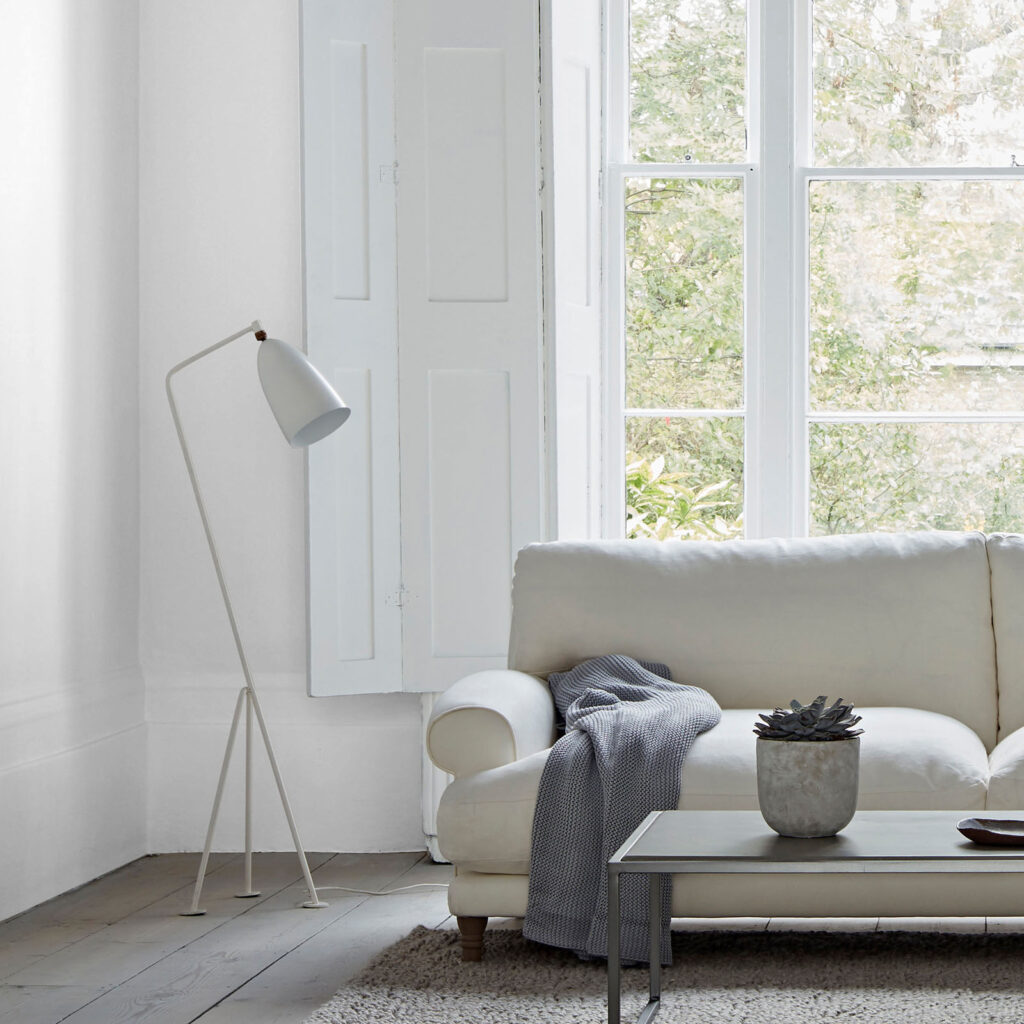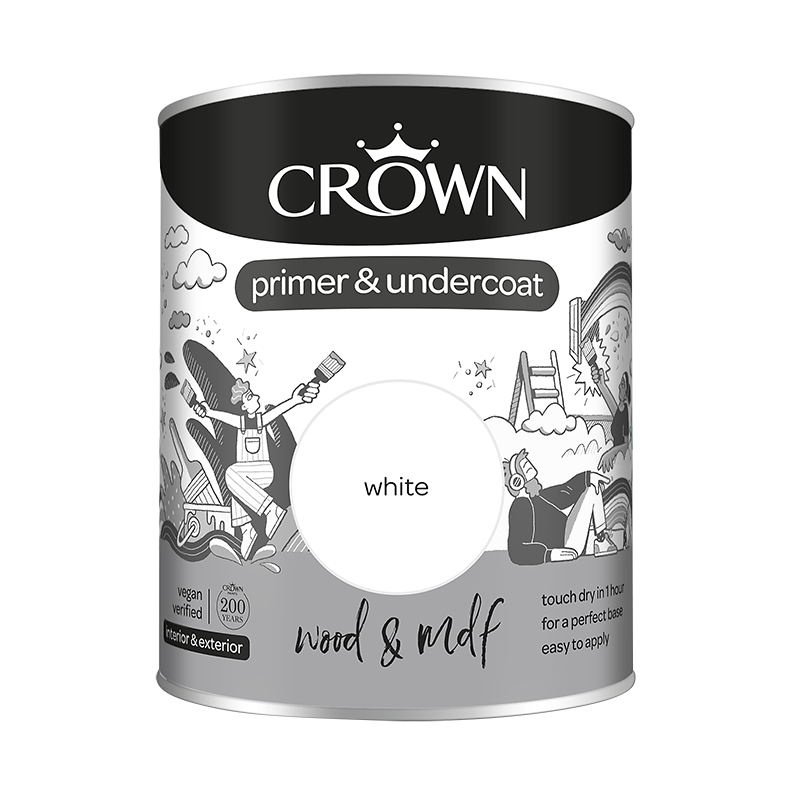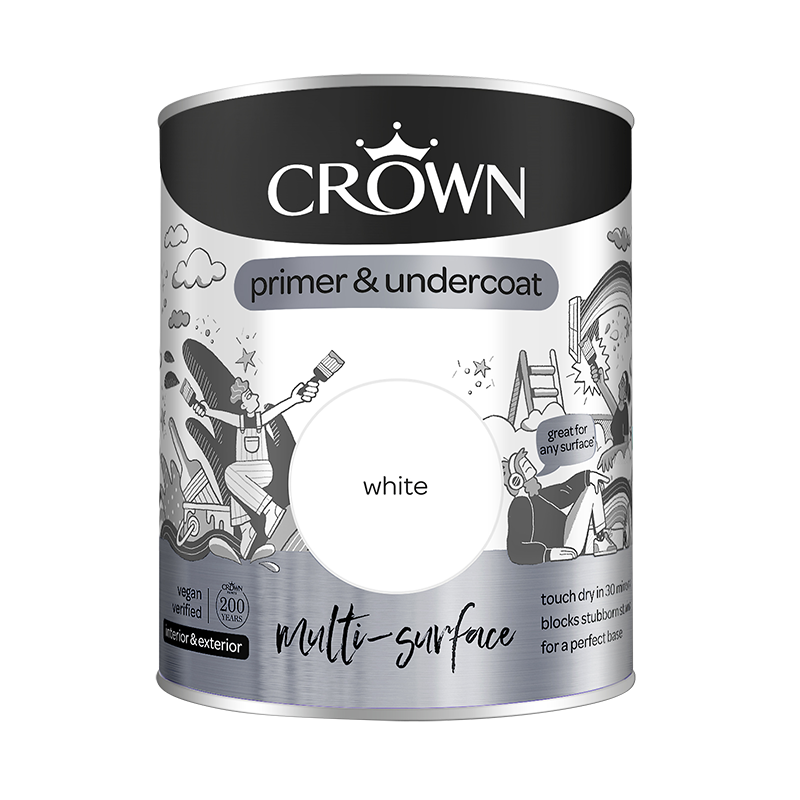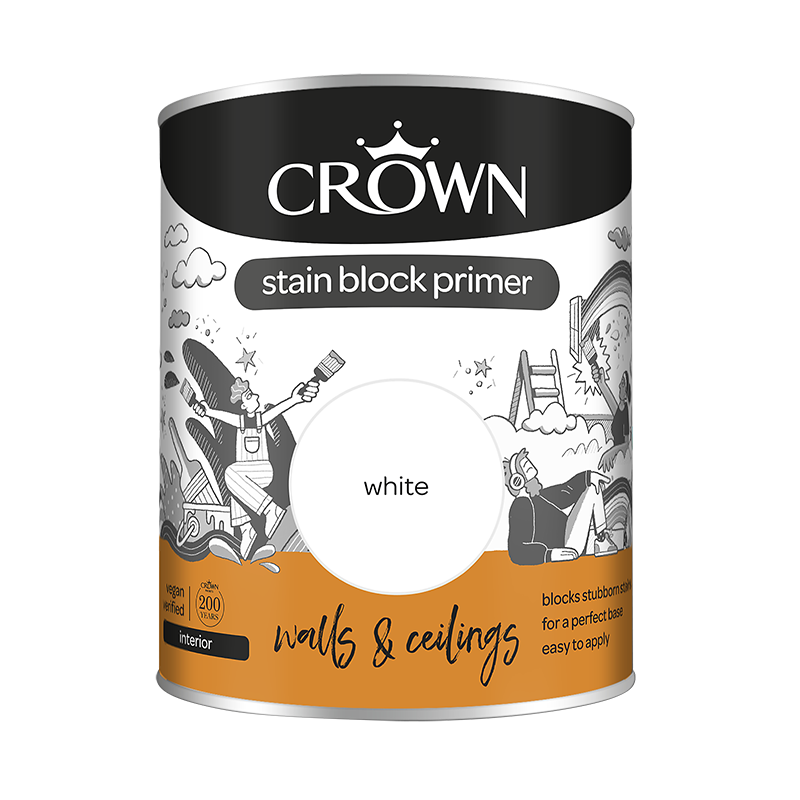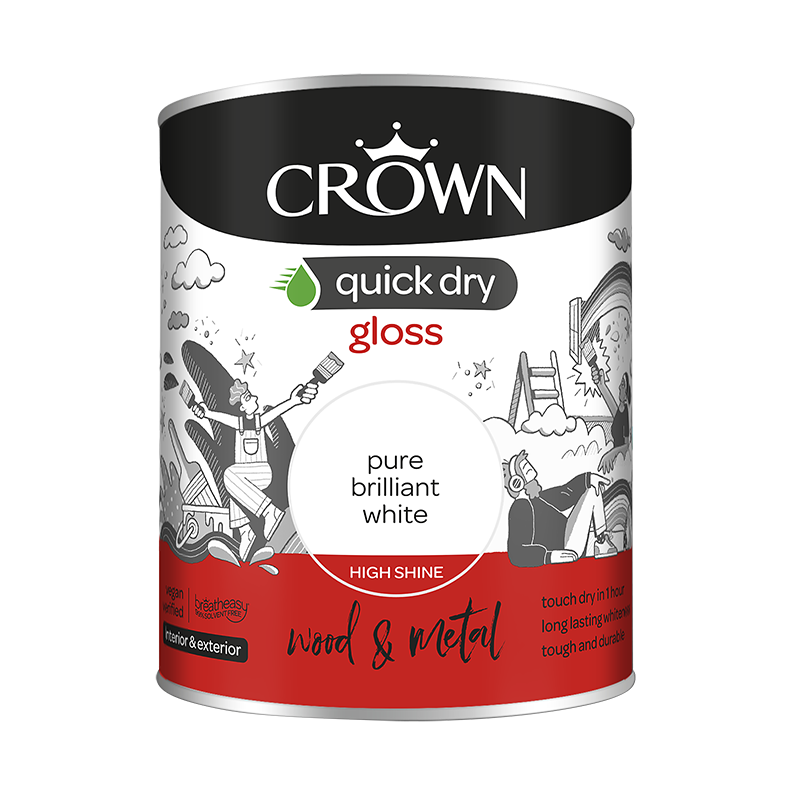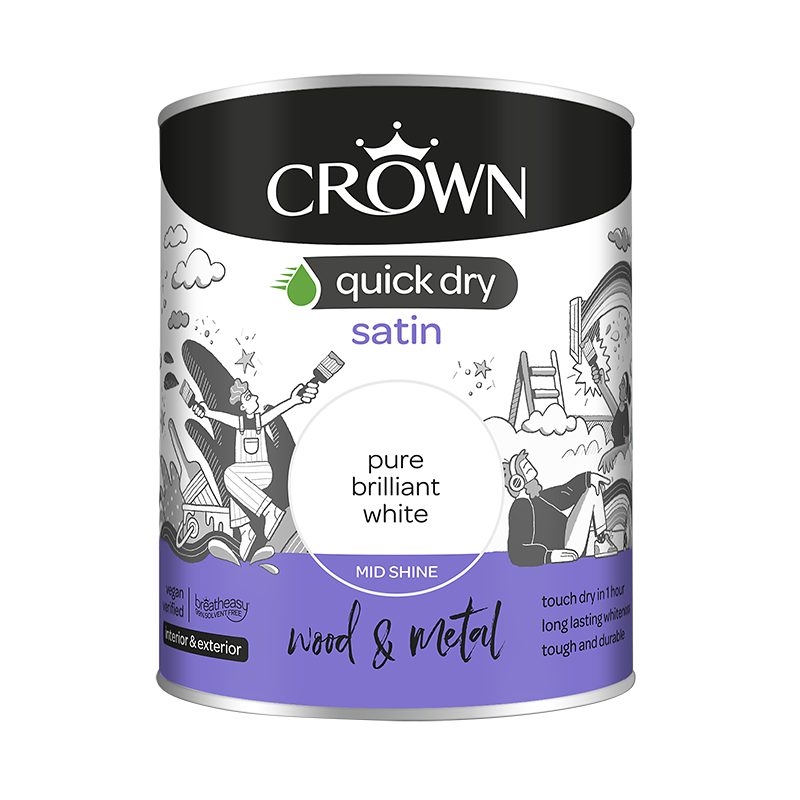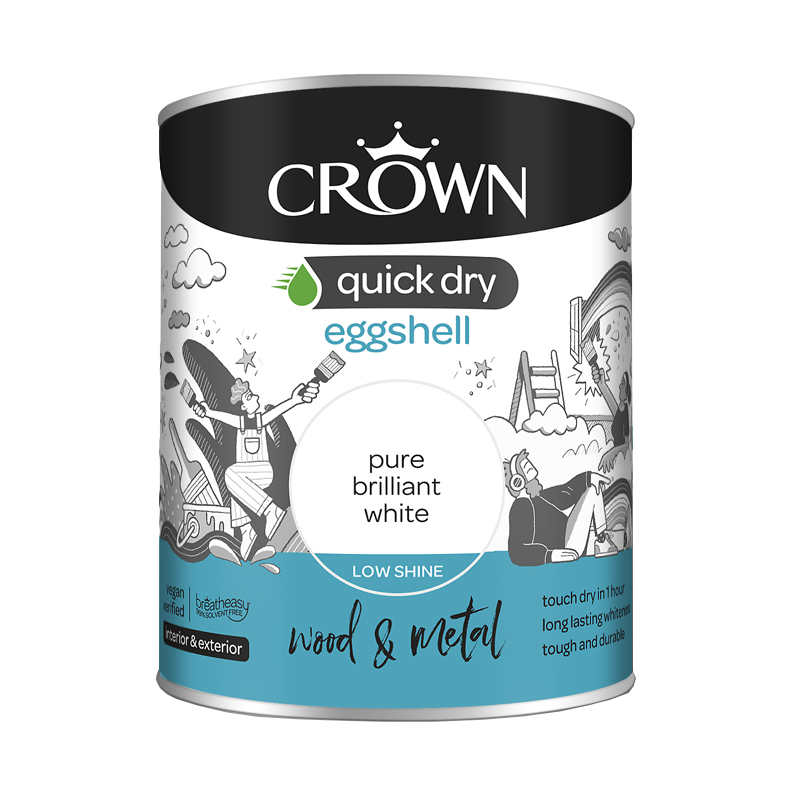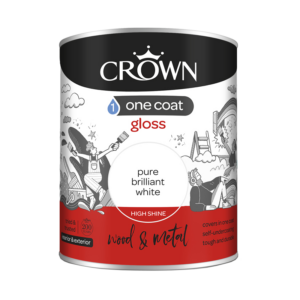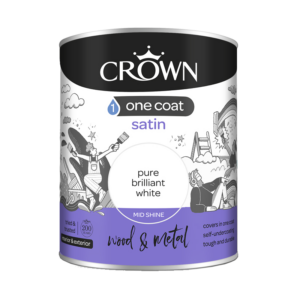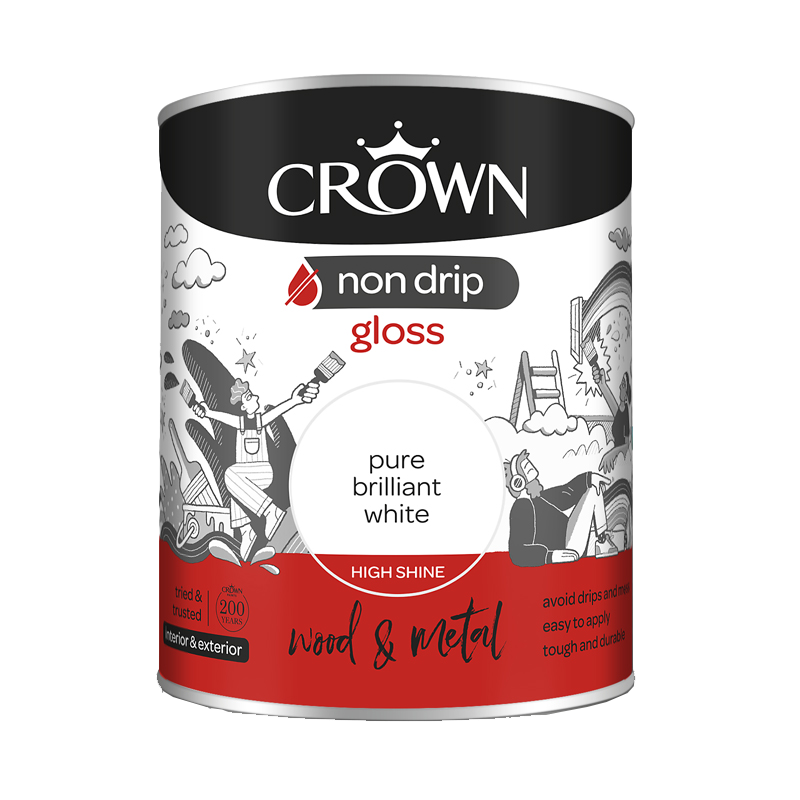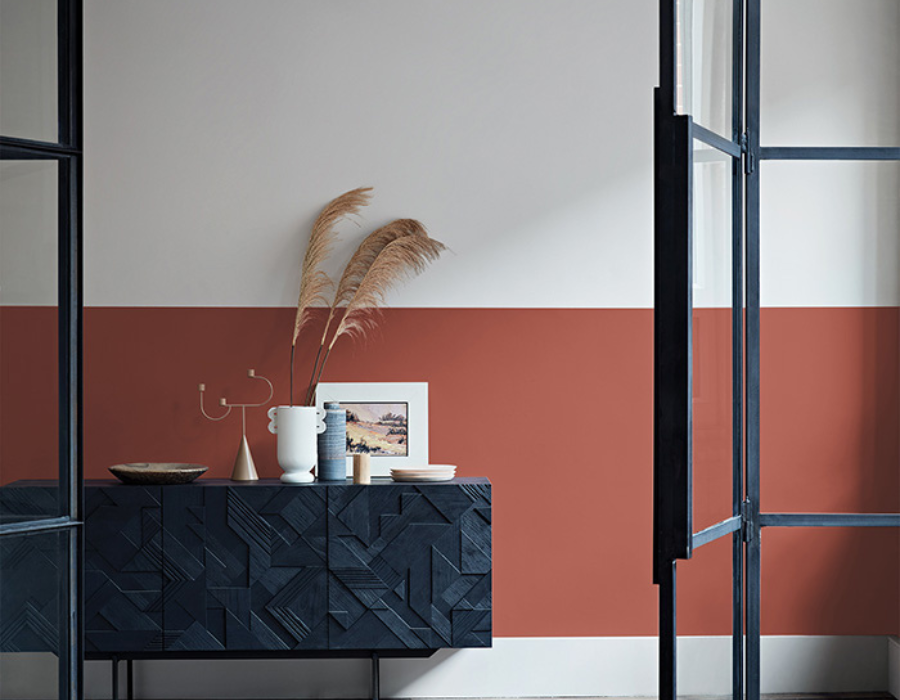If you’re gearing up to paint your doors, skirting boards, banisters, railings or window frames but your head is in a spin over what paint to use; whether to use a primer; if wood needs sanding or not; what the difference is between satin and eggshell; and what even is an undercoat? Don’t panic, we’re here to help.
The finishing touches make all the difference to a room, but sometimes painting woodwork and other decorative elements can seem like a complicated and long-winded task, and the idea of all that hard work simply peeling off isn’t worth thinking about. With these top tips and easy steps, ensure a perfect finish every time and decorate like a pro!
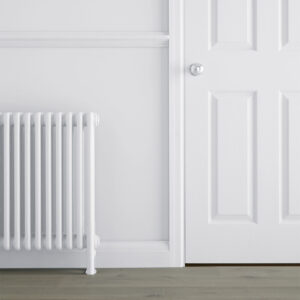
Crown Quick Dry Satin – Pure Brilliant White
What are you painting?
The first thing to consider is what type of surface you’re painting. Is it wood, metal, PVCu, ceramic, glass or something else? For most surfaces, if they’ve already been painted before and you’re just refreshing them, you can simply wash them down with a mild detergent – paying particular attention to areas where greasy hand marks may be present – before rinsing with clean water and lightly sanding to remove any previous sheen. Remember to wipe down again after sanding to remove any dust. These steps help your chosen paint stick properly for a long-lasting finish.
TOP TIP: When prepping a previously painted item, it’s important to clean it with a mild detergent first before lightly sanding, otherwise any dirt or grease will be pushed further into the surface when sanding, which can impact the overall finish.
If painting a bare surface such as a new piece of wood or metal that hasn’t previously been painted, you’ll need to use a suitable primer. There are different types of primer for different materials and it’s important to choose the correct kind for your project. For wood, use Crown’s Wood & MDF Primer & Undercoat, or if you’re painting metal, PVCu, melamine, glass or simply want the flexibility to use one primer on lots of different materials, choose Crown’s Multi-surface Primer & Undercoat with the added benefit of advanced stain block technology.
All Crown Wood & Metal paints can be used on suitably prepared wood, metal and PVCu.
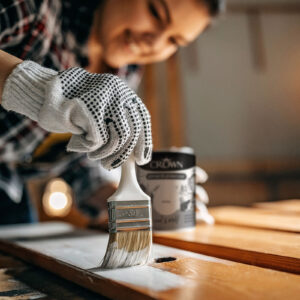
Crown Wood & MDF Primer & Undercoat
What’s the difference between a primer and undercoat? Do I need one?
Primers act as a foundation for your ‘top coat’ of paint. They penetrate into porous surfaces, sealing them to allow paint to adhere more successfully which means you’ll achieve a longer-lasting, more professional finish. If you don’t use a primer, paint can quickly begin to peel off, and nobody wants that!
Undercoats, on the other hand, are heavily pigmented and can be applied after priming and before painting to provide strong covering power to cover up old paint – particularly important if you’re going from a dark shade to a lighter shade. At Crown, we’ve combined these into our fantastic 2 in 1 Primer & Undercoats – so you have everything you need in one can and don’t have to do the job twice. Easy!
Prepping bare wood? Make sure you’ve treated knots and resinous parts with knotting solution and then apply our Wood & MDF Primer & Undercoat.
Prepping a whole array of materials and want to ensure no stains bleed through e.g. water stains, nicotine or smoke stains, crayon or pen? Then our Multi-surface Primer & Undercoat is the one for you.
They’re both made using water based formulations and can be used under both water or solvent/oil based paints. Not sure what that means? We’ll come onto that later!
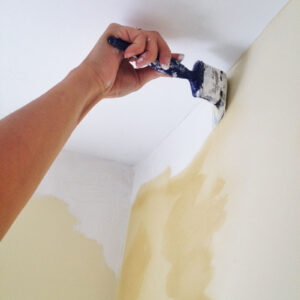
Crown Walls & Ceilings Stain Block Primer
Alternatively, you may be prepping walls for decorating. Unfortunately walls and ceilings sometimes develop nasty stains that can prove troublesome when painting – for example water stains from a leaky pipe, nicotine and smoke stains or even crayon and pen marks from creative kids. Crown’s Walls & Ceilings Stain Block Primer seals and prepares walls and ceilings, trapping stubborn stains in the primer to prevent it bleeding through your top coat of paint. It’s really important to allow stain blocking primers to dry for the specified time to ensure the stain is properly trapped before painting.

Crown Non Drip Gloss – Pure Brilliant White
What the hell is Eggshell, Satin and Gloss?
If finding the right paint for your project feels like a foreign language, we feel you… so let’s translate. The best place to start is with whether you’d prefer a Gloss, Satin or Eggshell finish. These are the terms used to describe the level of sheen of the finished paint – basically how shiny it looks! So if you’re after a super shiny look, Gloss is the one for you. Satin has a slight shine but is much more subtle than gloss for a more modern aesthetic. And Eggshell is named as such because it resembles the look of an eggshell, i.e. almost matt with a very very slight shine. Once you’ve decided what level of shininess you prefer, you can choose what type of performance you’d like from your paint.
Explore our range of Gloss, Satin and Eggshell paints here.
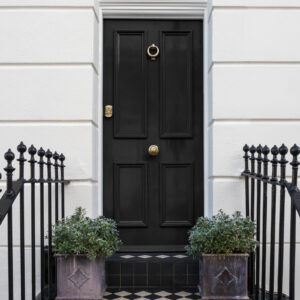
Crown Quick Dry Gloss – Jet Black
Ok, so which is the best paint for wood and metal?
The answer to this depends on what’s important to you.
Do you want to get the job done in a day and not have to worry about cleaning brushes and equipment with chemicals? Then our Quick Dry Gloss, Quick Dry Satin and Quick Dry Eggshell paints are right up your street. They’re water based and touch dry in just 1 hour, so if you’ve got pets or small children who are just itching to brush up against your beautiful new paintwork, you can breathe a sigh of relief that you only need to keep them apart for 60 minutes. They can also be recoated in just 6 hours so with careful planning you can get the whole job done in a day.
Our Quick Dry paints produce our longest lasting white finish, so if you want to ensure your skirting and door frames are the crispest, brightest white for longer, Quick Dry is the way to go. They also contain our popular breatheasy® 99% solvent free technology to limit exposure to airborne triggers of asthma and allergy and they’re independently Vegan Verified to not contain or be produced using ingredients derived from animals, creating a healthier environment for all.
Our Quick Dry paints are available in Pure Brilliant White, Jet Black and Anthracite.
If you’re all about doing the least amount of work, our One Coat Gloss and One Coat Satin is your perfect formulation. They have superior covering power so give a fabulous finish in just one application, saving time and effort, and they’re also self-undercoating so if you’re painting a previously coated surface there’s no need to apply an undercoat to help cover up old colours. Winner!
If you’re not too confident in your painting skills, a good option is to try a Non Drip paint. Available in a Gloss finish, this paint is ‘gelled’ so it sticks to your brush and doesn’t drip off and run everywhere to help avoid nightmare messes. Note: it’s really important not to stir Non Drip paint or it agitates the formula and temporarily loses its non-drippyness!
TOP TIP: Make sure you read the back of the can first before you start painting. There’s important guidance here on the steps to take, which type of brush to use and handy instructions like whether to stir your paint or not.
What’s the difference between water based and solvent/oil based paint?
You may hear people talk about paints being either water based or solvent/oil based, but what does that mean? This simply refers to the main substance used to carry the paint’s pigments and other ingredients, and these can either be water or a chemical solvent such as white spirit. Whether they’re water or solvent can impact the way the paint behaves.
Main differences:
- Drying Time: Water based paints dry much faster than solvent based paints as the water evaporates quickly, allowing the paint to dry, whereas solvents need more time to evaporate.
- Odour: Water based paints have low odour compared to solvent based paints.
- Environment: Water based paints contain fewer VOCs or ‘volatile organic compounds’ than solvent based paints. Our Quick Dry Gloss, Quick Dry Satin, and Quick Dry Eggshell are water based and contain Crown’s unique breatheasy® 99% solvent free technology, limiting exposure to airborne triggers of asthma and allergy. Along with our Preparation Products, they are also Vegan Verified.
- Clean up: It’s easier to clean up your equipment when using water based paints as you can simply used clean water.
- Durability: Solvent based paints often provide better durability, so you may prefer to use these for outdoor applications, although our water based Wood & Metal Paints and Primers are also great for use outside the home.
- Long lasting whiteness: Water based paints provide longer lasting whiteness compared to solvent based paints which can yellow slightly over time.
Shall I use a brush or roller?
The majority of the time, it’s completely up to you whether you use a brush or roller and you may be led by the item you’re painting (it’s tricky to get a roller into small nooks and crannies!). But it is important to read the back of the can first as some paints are best applied using a brush e.g. One Coat Gloss and One Coat Satin.
Ultimately, it’s completely down to personal preference and what works best for you. Hopefully this handy guide helps you on your decorating journey. Explore our full range of Wood & Metal Paints and Primer & Undercoats or find a retailer near you.
